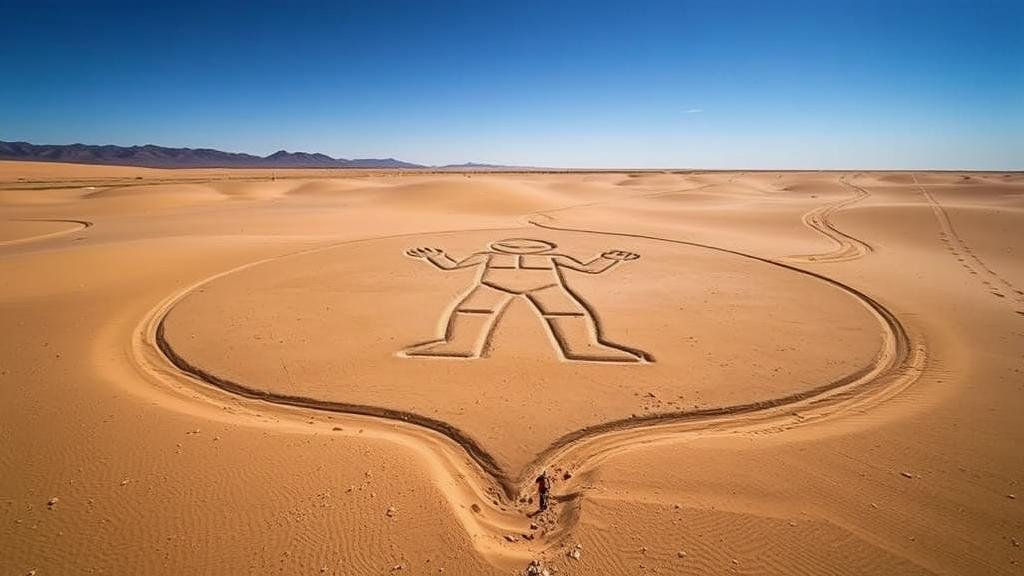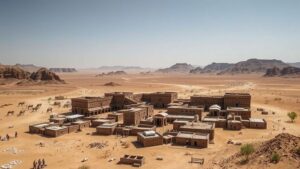Searching for the significance of the “Nazca Astronaut,” a figure etched into Peru’s desert.
The Significance of the Nazca Astronaut
Located in the arid Nazca Desert of southern Peru, the Nazca Astronaut is a geoglyph that has captivated the imaginations of archaeologists, historians, and enthusiasts alike. This enigmatic figure, etched into the earth’s surface, is part of the larger Nazca Lines complex, which consists of numerous figures and lines made by removing reddish pebbles to reveal the lighter-colored earth underneath. The Nazca Astronaut, along with the other geoglyphs, is believed to have been created between 500 BC and 500 AD by the Nazca culture.
The Structure and Appearance of the Nazca Astronaut
The Nazca Astronaut, also referred to as the Astronaut Figure, is distinct for its humanoid shape, which appears to be wearing a helmet and suggests a figure gazing upward. Measuring approximately 32 meters in length, the figure features a prominent head, arm-like appendages, and legs. Its composition is particularly notable for its resemblance to depictions often associated with modern interpretations of extraterrestrial beings, thus igniting theories about ancient astronaut contact.
Cultural Context: The Nazca Civilization
The Nazca civilization thrived in the region that is now Peru from around 200 BC until 600 AD. Renowned for their advanced agricultural practices, pottery, and textile work, the Nazca people are perhaps most famous for the creation of geoglyphs. e designs served various purposes, including ritualistic practices, astronomical alignments, and, potentially, as pathways for ceremonial processions.
- The geoglyphs were primarily constructed using simple tools to remove surface stones, creating a stark contrast between the reddish earth and the lighter soil beneath.
- The Nazca people may have used these designs as part of their worship practices, appealing to deities for agricultural fertility or water accessibility.
Theories Surrounding the Nazca Astronaut
The Nazca Astronaut has spurred a variety of theories regarding its meaning and purpose. Some of the most prevalent ideas include:
- Ancient Astronaut Theories: Proponents of this theory suggest that the figure represents an extraterrestrial being. Such interpretations gained traction in the mid-20th century, with the publication of works like Erich von Dänikens Chariots of the Gods?
- Astronomical Significance: Another perspective posits that the figure may serve as an astronomical marker or a calendar-related design guiding the Nazcas agricultural cycles.
- Cultural Symbolism: Many archaeologists argue that instead of representing aliens, the figure likely holds significant cultural symbolism pertaining to the Nazca’s mythology and deities.
Archaeological Findings and Research
Investigations into the Nazca Lines, including the Astronaut figure, have involved extensive aerial surveys and ground studies. Researchers have utilized various tools, including drone technology and Geographic Information Systems (GIS), to map and analyze the lines. For example, a study conducted by the National Geographic Society in 1997 provided insights into the patterns and potential rituals associated with these geoglyphs.
The Impact of Preservation Efforts
Despite the figurations cultural significance, the Nazca Lines face threats from urban development, climate change, and tourism. In response, the Peruvian government has implemented various protective measures, including designating Nazca as a UNESCO World Heritage Site in 1994. Preservation efforts have included limiting access to sensitive areas and promoting sustainable tourism practices.
Conclusion: The Nazca Astronaut’s Enduring Mystery
The Nazca Astronaut remains a compelling subject for both scholarly research and public intrigue. As we continue to explore its significance, it serves as a reminder of humanitys innate curiosity and the intricate connection between culture, symbolism, and the great unknown. Future research and conservation efforts will be crucial in ensuring that this remarkable piece of history is preserved for generations to come.
Actionable Takeaways
- Consider visiting the Nazca Lines for a firsthand experience of this ancient wonder while adhering to sustainable tourism practices.
- Engage with literature on Nazca culture and archaeology to further understand the context surrounding such geoglyphs.
- Support conservation efforts that help preserve archaeological sites threatened by modern development.



